#Trombidium
Text
@dragonwysper submitted: Gonna share some mites because I’m an Acari fanatic. I already know the families (and some genera) of these, so no need for ID! I just wanted to share some of what are objectively the Best Creatures ™. All of these are from the [[removed]]* area of Missouri!
*please redact
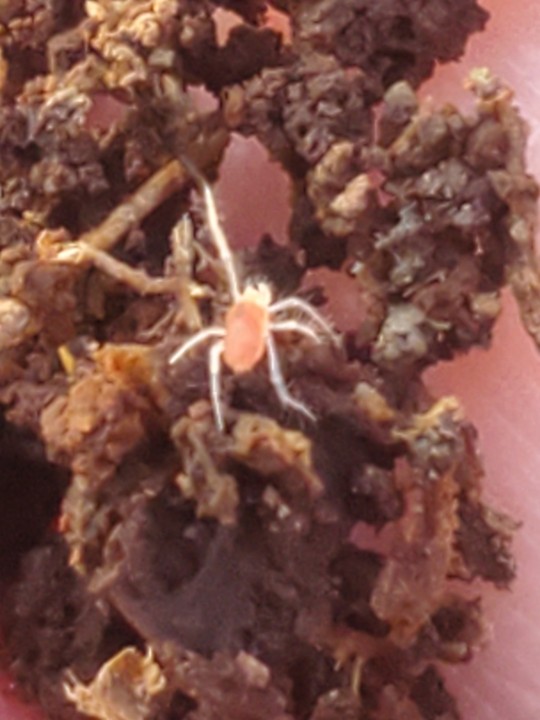
A Rhagidiidae I found under a log! Very speedy creechur. It was hard to get photos of him haha!

Balaustium sp.! Sidewalk mites! They’re very goofy. I’ve found that if you lightly touch them, they will zip away from you, while spinning to face whatever you’ve touched them with. I have no idea why they do this, though I’ve considered it may be related to a substance they’ve been found to secrete when distressed.

Big Trombidium sp. in a pill bottle (because that’s what I had at the time haha. The perks of being mentally ill…). I released this guy after taking some photos, and then was contacted by Ray Fisher (an American acarologist), who asked if I would be willing to send him over for study. I went back out to refind this guy (which, by the way, is ridiculously hard to do with a mite in a woodpile). I did find him again, and sent him over to Fisher! I still send him specimens from time to time, as he’s working on reorganizing the Trombidiform taxon! I have a potential opportunity to get to name a new species with this (since American mites are severely understudied and everything I’ve sent in is an undescribed species), and I’m overall just really excited to be working with him!

A Trombidium sp. on my hand! They’re so large for mites!
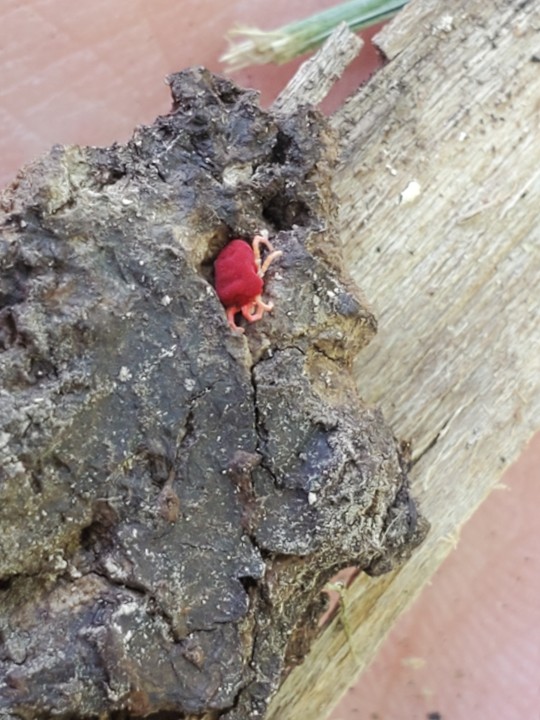
A Trombidiform of some kind in a log crevice! I really like this guy’s little white legs haha.

Same guy from above with a fellow Trombidiform (Trombidium sp.)!

Trombidium sp. belly!! I took a lot of photos of the ventral sides of these mites. They have two major openings (aside from the mouth): the genital plate and the anus. The genital plate is the little mitussy in the center of this guy’s belly, and the anus is at the end of his abdomen (right in the middle of his little mite cheeks)!
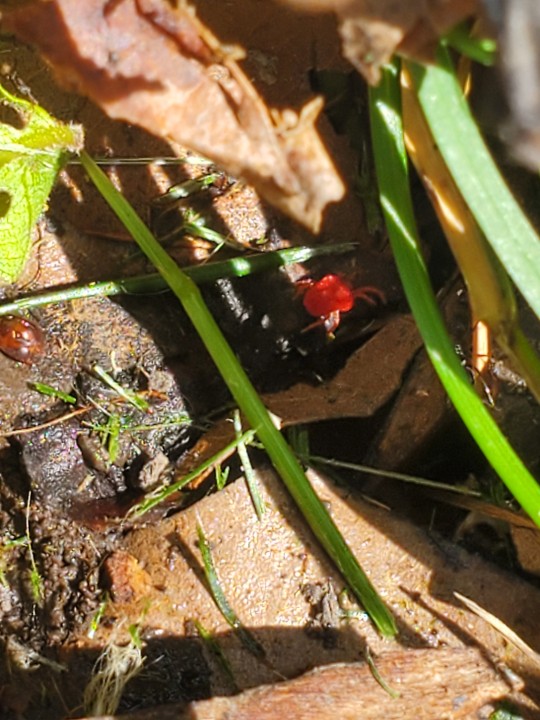
Trombidium sp. in the wild. It’s so fucking funny to me how BRIGHT they are. He looks so out of place in the grass, but he’s supposed to be here, and it’s just 😭😭
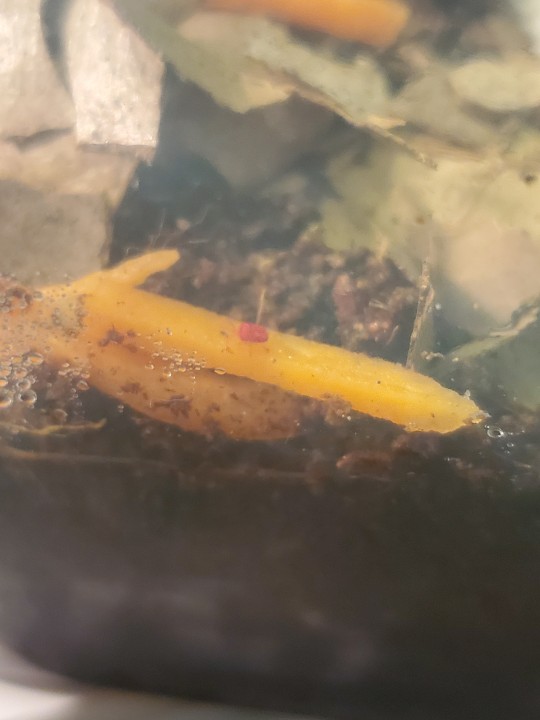
Fun story with this little Trombidium sp.! So I had a lightning bug in a container (for a miscellaneous mite project), and found a tiny little pupa in there after a couple days! I texted Fisher and was like “👀 what is he,” and he told me it was a Trombidium that had been parasitizing the lightning bug! So, with his instruction, I took the little guy out of the tank and put him in a separate pill bottle to wait for him to emerge. He did after about a week or two, into a smaller version of the mites I see outside! I’ve currently got him in a really tiny bioactive terrarium. I need to send him to Fisher, but I’m lazy and haven’t gotten around to it yet haha.
This little mite will routinely burrow down in the dirt and stay hidden in there for a couple weeks at a time, before randomly popping up to wander about on the surface. He’s made me worry he was dead more than once. But he always turns up! Absolute goober. I feel obligated to name him, but I haven’t gotten around to that either.
Image shows the lad on a carrot shaving, which is in there as food for the springtails and isopods!

And!! Last but not least, a young tick! I don’t actually know what kind of tick this guy is. He’s probably a Lone Star (Amblyomma americanum) because we have a lot of those around here, but I don’t know for sure haha. If you do, feel free to ID him for me!
So this guy is included because he is a mite! Ticks are usually separated from other mites based on an arbitrary categorization of shielded or thick-skinned vertebrate parasites versus everything else, but they are very much in the Acari subclass! They make up two families in the Parasitiform order, Ixodidae (hard ticks) and Argasidae (soft ticks). Ixodidae, a large order of about 17 genera, are what you see in North America and Europe, while Argasidae, made up of 5 accepted genera, are more common in South Asia.
Since they’re very much mites, they also deserve appreciation because they are wonderful and beautiful and fascinating.
…
Please let me know if you want me to send you more mite rambles, because Acari are my biggest hyperfixation at the moment and I love talking about them ❤️
MITE TIME!!!! Oh boy I love mites and they are severely underrated. This is an excellent collection of lads. I don’t wanna play favorites but that first dude has VERY silly legs and I love him deeply 🥺 But I also love the parasitic dude you found in the firefly container. I’ve definitely seen juvenile mites attached to bugs, so it’s fun to find one who had dropped off! Name suggestion: Goober.
PLEASE let me know if you get to name a species, that would be very exciting.
I agree ticks are wonderful and fascinating! Your little pal looks like Amblyomma sp., which would include the lone star tick so that’s more likely since they’re very common in your area. But there’s also the golf coast tick in the same genus that’s found in your area, too, and I wouldn’t know how to differentiate them as juveniles.
Feel free to share mite photos any time you like! Although I will say just a few photos per submission tends to be easier for people to read/reblog! Lots of people will block very long posts or not bother looking at them at all.
Btw dying at “mitussy” omg
#animals#bugs#arachnids#submission#mite#acari#acarology#rhagidiidae#trombidium#trombidiformes#velvet mite#balaustium#tick#long post#parasite
96 notes
·
View notes
Text
So I have a little Trombidium mite in a teeny tiny terrarium that I raised from a pupa (after finding him pupating in a container I put a firefly in) for scientific purposes. I highkey have just left him in the little terrarium for several months now, and he routinely just Disappears and I don't see him for a few weeks at a time. Well he disappeared like three months back, and I kinda forgot about him until like last week, when I used a stick to prod through the dirt to try and find him. I did not succeed. I resigned myself to waiting for the freshly misted dirt to dry before digging out his corpse to send to an acarologist friend, and then put that off too.
So anyways, I just got home today, and bro was just out crawling around on a leaf.
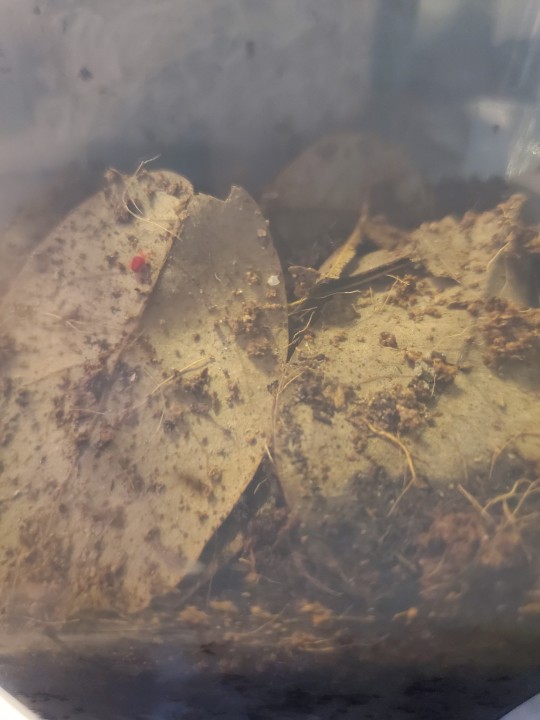

Remind me not to underestimate him again.
#he needs a name#mite#mites#Trombidiidae#Trombidiformes#Trombidium#velvet mite#arthropods#bugs#arachnids#red bug#little baby man#entomology#acarology#pet bugs#i fucking love mites#bugs /
2 notes
·
View notes
Text
mite time :)

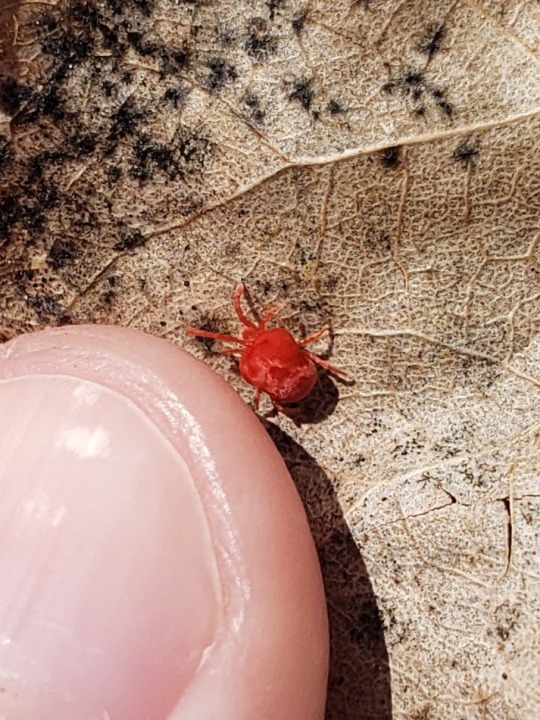


bonus beetle impression:

#delightful lumpy beast#trombidium sp#red velvet mite#mine#bugblr#they're harmless before anyone worries for my fingers
367 notes
·
View notes
Text

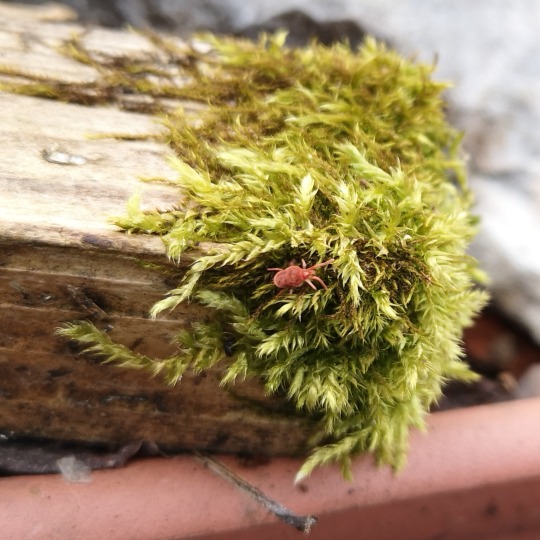

[ID: Three pictures of a red mite sitting on mossy wood.]
#it's probably a rote Samtmilbe :)#Trombidium holosericeum. Apparently. IF I identified it correctly ofc.#bugs#mites#bugblr#rote Samtmilbe would be red velvet-mite in english btw. It does look kinda velvety!
34 notes
·
View notes
Text


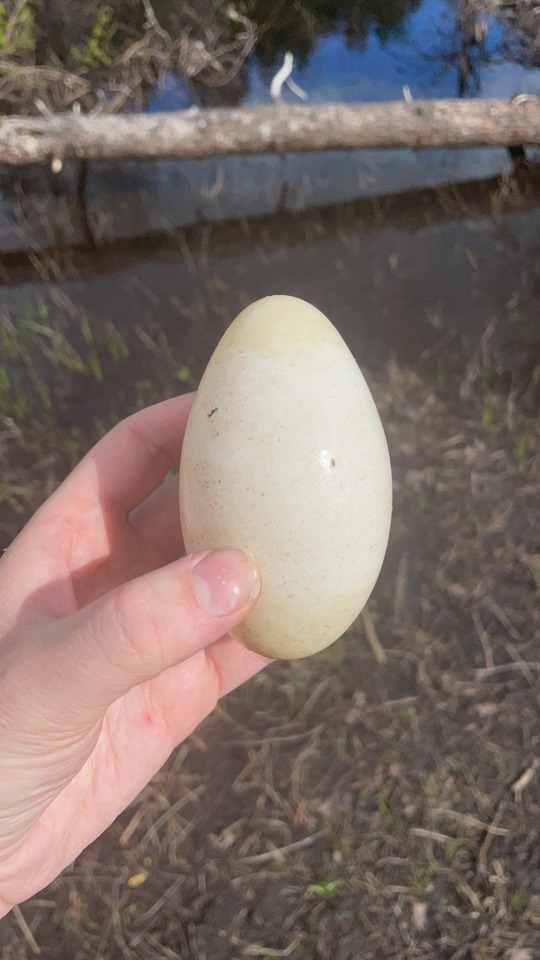



Some creatures from today.
Left to right: RSN, green sungill, a massive egg I found in the water (no nest nearby at all how did it get there?!), genus trombidium, water mite (it looked like a tick but it was aquatic!) and a yellow spotted millepede
#bug#bugs#fish#fish was released#I also caught and released a cutthroat but failed to photograph it#what kind of bird made that egg? I left it on the shore and then my dog ate it#it was very much dead it’d been submerged for a while
48 notes
·
View notes
Text
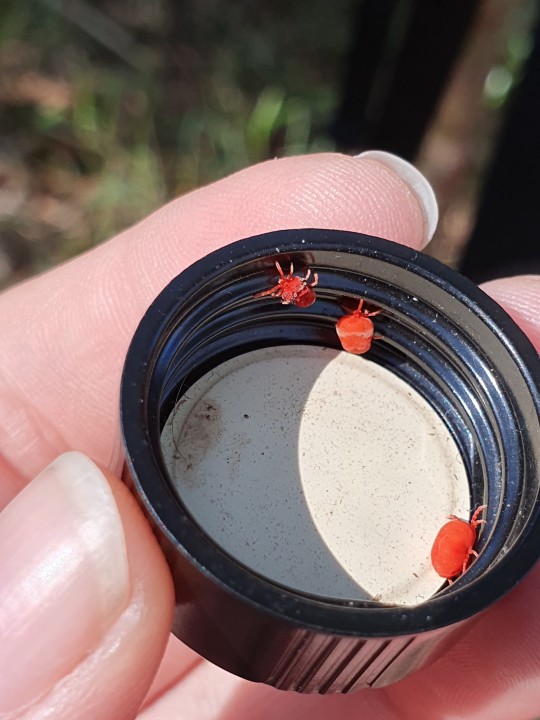



Red velvet mite - Trombidium family
Wedderburn, NSW, 2 May 2023
#red velvet mites#mite#arachnids#arthropods#bug of the day#entymology#my photography#bug girl#bugs#red
1 note
·
View note
Photo
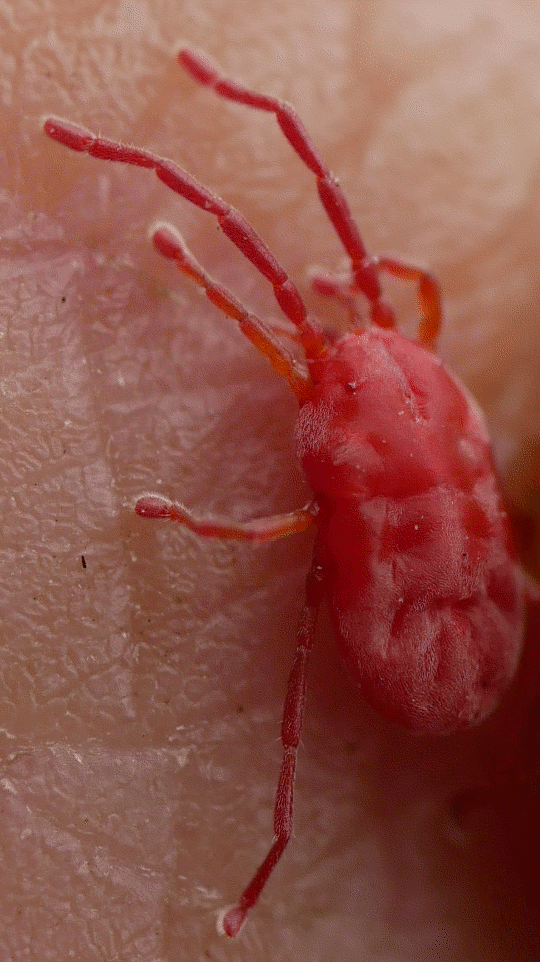
42 notes
·
View notes
Photo
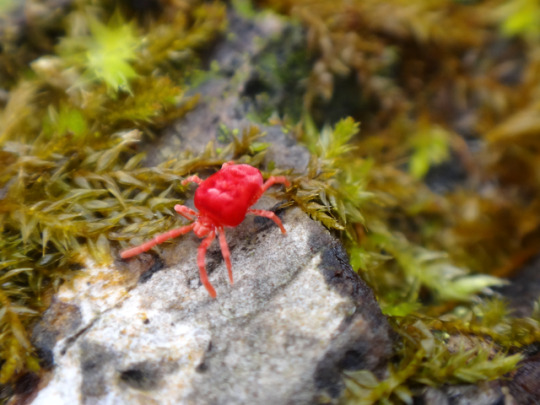
Velvet Mite (Trombidium sp.)
39 notes
·
View notes
Photo
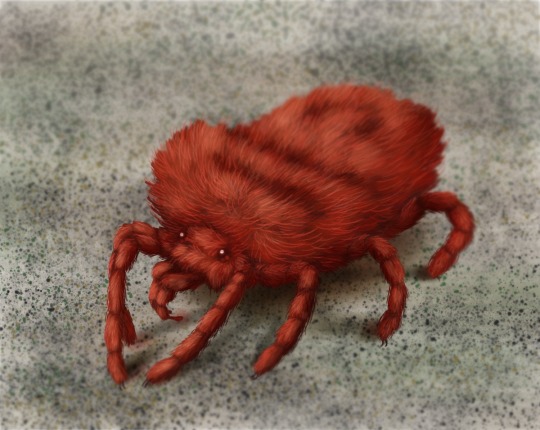
Red velvet mite.
12 notes
·
View notes
Photo
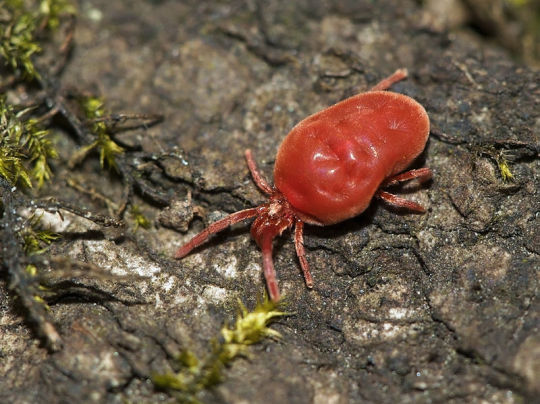
Trombidium holosericeum
Trombidium holosericeum is a species of mite in the genus Trombidium, commonly called the velvet mite. This species is one of the largest mites in northern temperate zones, with a body length of about 4 mm. Its bright red color results from carotenoids, warning predators about the toxicity of the mite. While adults live freely and are often found wandering about, searching for small animals and insect eggs for food, the larvae try to find a host to attach themselves to, often an insect like a grasshopper or diptere, but also arachnids like harvestmen or spiders.
photo credits: Jörg Hempel
#trombidium holosericeum#velvet mite#mite#zoology#biology#biodiversity#science#wildlife#nature#animals#cool critters
147 notes
·
View notes
Text
Lovely, Dark, and Eternal
Lovely, Dark, and Eternal

Image courtesy of Melina Stahopoulos on Flickr
Bare tangled branches up against a cerulean blue. That’s all I see when I raise my binoculars and search for the Pileated Woodpecker I keep hearing. The woods, especially unfamiliar ones, can have tricky acoustics. Is the sound bouncing off the small peak that I just summited? The noise was ahead of me, and now it is behind me. I sigh and squirm on…
View On WordPress
#comfort in nature#Connecticut#Connecticut Forest and Park Association#Highlawn Forest#Pippa Passes#Robert Browning#spring#Trombidium
0 notes
Photo
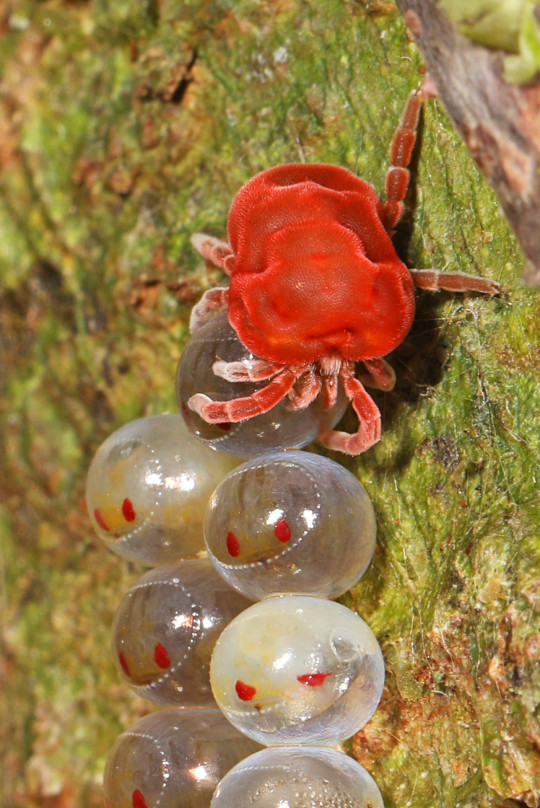
Velvet mite, Trombidium sp.?, Trombidiidae, with Hemipteran eggs
Photographed in Ecuador by Judy Gallagher
#animals#curators on tumblr#bugs#arachnids#mite#velvet mite#red velvet mite#Trombidium#egg#eggs#congregation#cluster#true bugs#Hemiptera#one nice bug
1K notes
·
View notes
Photo
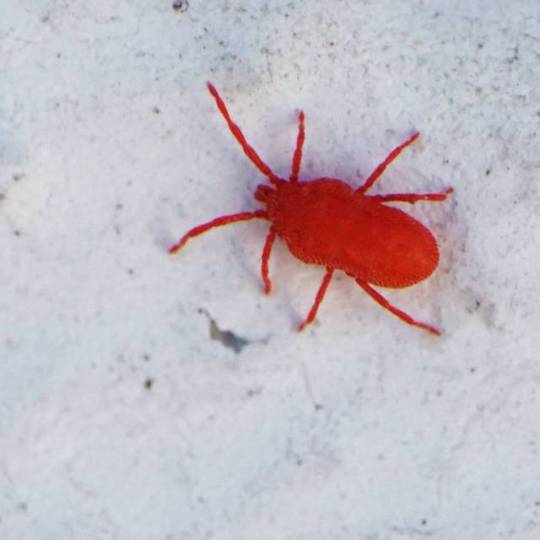
You know those tiny insects that crawl on walls and stones ? The ones that leave a red mark when squished ?A lot of people call them "red spiders"... I managed to take this picture that helped me investigate and it turns out they're not spiders at all ; they're mites and they actually predate other, potentially harmful, mites. #youlearnsomethingneweveryday #mites #acarien #acariens #trombidium #araignee #spider #araignéesrouges
0 notes
Photo

Trombidium holosericeum is a species of mite in the genus Trombidium. It occurs in Europe, Asia, and North Africa and is commonly confused with other red mite species. Scientific name: Trombidium holosericeum Higher classification: Trombidium Rank: Species Family: Trombidiidae Info extracted From - Google #Sky #Flowers #Colourful #PhotoGraphy #Waterfall #NaturePhotos #Tree #Amazing #Moon #Darkmoon #DarkSky #Sunset #photographer #Forest #Village #Road #Wonderful #Activities #Livinglife #Nature #Sun #Sunrising #Boats #Varanasi_Banaras #Space #Girls #Fashion #Modeling #Trombidium holosericeum #redbug (at Hanuman Temple Daniyalpur) https://www.instagram.com/p/CRihFcYAyhX/?utm_medium=tumblr
#sky#flowers#colourful#photography#waterfall#naturephotos#tree#amazing#moon#darkmoon#darksky#sunset#photographer#forest#village#road#wonderful#activities#livinglife#nature#sun#sunrising#boats#varanasi_banaras#space#girls#fashion#modeling#trombidium#redbug
1 note
·
View note
Link
Quando le temperature raggiungono i 20 gradi escono dai loro nascondigli. E attenzione: sono indelebili
Una rondine non fa primavera. Ma i ragnetti rossi, che in questi giorni stanno invadendo mura e terrazze, invece sì. Perché il Trombidium holosericeum, l’acaro che comunemente chiamiamo ragnetto rosso, esce dal suo nascondiglio soltanto pochi giorni all’anno. Quando cioè la temperatura raggiunge valori intorno ai 20 gradi ed il sole comincia anche a riscaldare e rendere il clima mite. Insomma: quando è finalmente primavera. E non si può sbagliare: temperature troppo rigide ne limitano i movimenti, il troppo caldo invece li uccide. E guai a schiacciarli, poiché le conseguenze del gesto potrebbe restare indelebile.
Non c’entra nulla la scaramanzia che vuole i ragni portatori di buone notizie, prima di tutto perché si tratta di acari. Il «vero» ragno rosso è un nemico per le piante. Lui, invece, l’acaro ricaricabile non comporta rischi sanitari, è completamente innocuo ed è anche difficile che entri in casa o che cerchi il contatto con l’uomo o anche con gli animali, come ad esempio cani e gatti. E non ha conseguenze neppure sulle piante, spesso ricoperte dai ragnetti rossi solo perché — almeno i più piccoli — si nutrono di larve. È un rischio però per le proprie pareti (in questi giorni completamente invase) e soprattutto per gli abiti, perché se schiacciati rilasciano una sostanza rossa indelebile, impossibile nella maggior parte dei casi da lavare via. Perchè non è sangue, ma emolinfa classica degli insetti che in questo caso è di colore rosso grazie ai carotenoidi, un avvertimento (piuttosto evidente) ai predatori: «È un acaro intelligentissimo, forse anche più degli uomini — spiega tra il serio e il faceto Riziero Tiberi, docente di Entomologia Forestale all’ Università di Firenze — Capisco che gli insetti provocano rigetto ed è dunque difficile guardali sotto un altro punto di vista, ma questi acari oltre ad essere del tutto innocui ed ignorare completamente l’uomo, sfruttano questi periodi miti per raggiungere i valori funzionali alle proprie attività».
In pratica sono ragnetti ricaricabili, perché durante l’inverno si nascondono tra le piante, sotto le cortecce degli alberi, dosando quell’energia accumulata con il sole in primavera. Per questo si concentrano sulle pareti e ringhiere, li dove il sole batte e la temperatura è piuttosto alta. In estate si nascondono perché il troppo caldo potrebbe ucciderli: «L’invasione durerà qualche giorno, ma non c’è alcun rischio igienico sanitario, né pericolo perché non mordono — ribadisce il professore Tiberi — Bisogna fare attenzione a non schiacciarli: se ce li ritroviamo sugli abiti bisogna scuotere gli indumenti, altrimenti il colore rosso ce lo ritroveremo per sempre come ricordo. Se invece invadono i nostri pavimenti basta anche soltanto l’acqua fredda che li lava via, perché i vecchi rimedi sono sempre efficaci». Nutrendosi di escrementi degli uccelli (almeno per i ragnetti adulti) tendono a concentrarsi, dunque, in luoghi frequentati da volatili, piccioni inclusi. Completamente inutile l’utilizzo di insetticidi o altro, non si ottengono risultati, se non quello di inquinare (inutilmente) l’ambiente. L’unica cosa da fare è dunque attendere che si ricaricano. E nel frattempo fare spazio negli armadi ai soli abiti estivi, perché quando finirà l’invasione dei ragnetti rossi mancheranno pochissimi giorni all’estate.
0 notes
Text
🕷Red Velvet Mite🔴
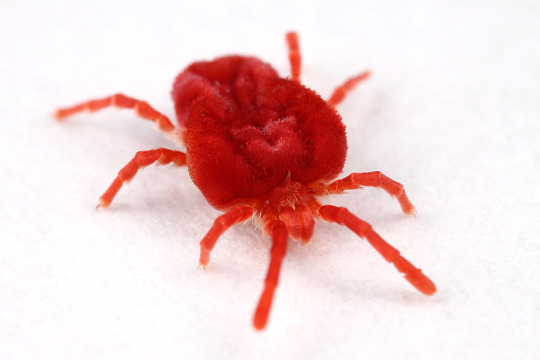
There are thousands of species of velvet mites.
This fuzzy little dude is a red velvet mite. They’re in kingdom Animalia, phylum Arthropoda, class Arachnida, order Tromidiformes, family Trombidiidae, and genus Trombidium. Their scientific name is Trombidiidae.

Trombidiidae Squad goals ^
They are found in dry lands and deserts, usually in northern parts of India, as well as around organic soil. They stay underground most of the year and will only be spotted outside after it rains and will spend this time outside looking for food and a mate. Their main prey are termites and their eggs.
The male leaves spermatophore on plants with woven silk paths leading to them to invite the female to fertilize them. If another male finds where another has left his spermatophore, he will instead break them and leave his own. If the female is interested, she will fertilize them.
Up to 100,000 eggs are laid in the soil or sand and take about a month to hatch. Their life begins as pre-larvae and they will remain close to their hatching site. As larvae, they live off small insects and only have six legs at this time. They go through several other unique stages until they become an adult.

Red velvet mites are harmless to humans.
They evolve from simpler, much smaller mites such as the ancestors of dust mites.
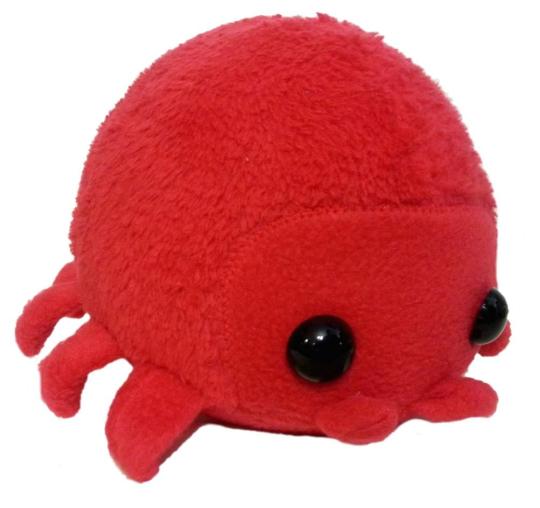
Also, you can get a cute red velvet mite plush here!
2 notes
·
View notes